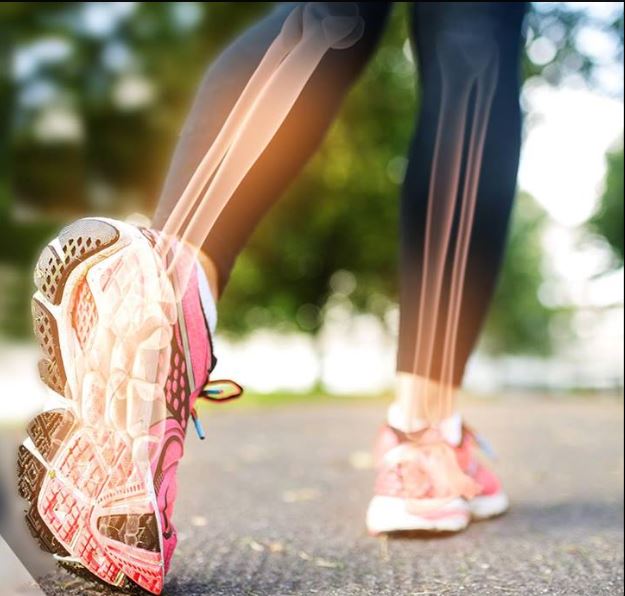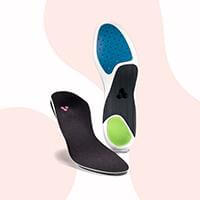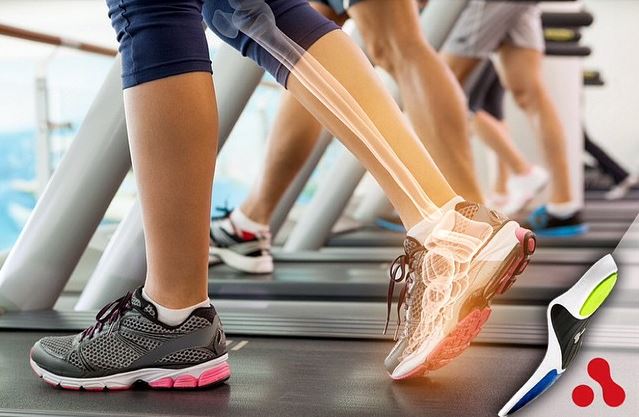What are the symptoms of shin splints?
Shin splints are tenderness or pain in front of and along the length of the shinbone. Some people feel the symptoms high up on the shinbone or just below the knee, whereas others feel pain lower down towards the ankle. Others still feel shin splint pain along the full length of the shinbone. You can often provoke a clear pain response by pressing on the point at which you feel pain. In severe cases, pain may radiate down into the foot. There is a good reason for this: The muscles that lift and support the foot and maintain foot position originate on the shinbone and extend down to the inner side of the foot. If you are suffering from an inflamed shinbone in connection with running, you will often find that the pain and tenderness is most obvious early in a training session. Once your muscles are warmed up, the tenderness will disappear only to reappear hours later or even the day after your training run. Massage is often an effective way to treat the symptoms if shin splints have become a problem. 
What causes shin splints?
Several factors can cause shin splints, e.g. knee and hip position, your running style and underlay. If you suffer from shin splints, they could be caused by incorrect foot movement in relation to your knee and hip, that your foot is misaligned or that it functions incorrectly, or all three. Shin splints can also be triggered by more complex physical misalignment, although the most common causes of shin splints originate in the feet. When you run and set off at speed, your feet work monotonous overtime. There is a consequential increased risk of muscular strain, with e.g. shin splints or tender shinbones as the result. Many of us know how it feels to wear uncomfortable footwear. If we wear the wrong shoes for a short time, nothing is likely to happen. If we wear the same shoes for some time, we get blisters. The same applies if you have a foot that has an incorrect or crooked position – which can result in shin splints. If we walk for a short time on a foot that functions incorrectly or is otherwise crooked, nothing is likely to happen. However, if you were to run or walk several kilometres (2 km is probably sufficient), you could easily trigger shin splits. 
What treatment is available?
The goal of any course of treatment is to reduce inflammation, relieve acute symptoms and prevent a recurrence of the irritation. In mild/moderate cases, rest is advised. Medication may be prescribed. If medication does not work, surgery may be required.
It is important to investigate the cause of the problem. Seek medical advice. If you are flat-footed, have very high arches or if your foot rotates downward, the foot is misaligned. In such cases, insoles are a good solution as they help to align the foot and prevent incorrect tension on the muscles around the shinbone.
You may find it beneficial to train with a physiotherapist’s guidance. The physiotherapist can also help you to correct or compensate for an incorrect foot position. A physiotherapist can also suggest stretching exercises and offer good advice about alternative training methods. An analysis of your running gait can establish whether your foot pronates or supinates. If you either pronate or supinate, you should obtain insoles that support the inner side of the foot well, under the arch and back towards the heel. Insoles can correct strain of the foot/calf and reduce the risk of developing problems.
Medication is likely to have only a little effect. For short periods with acute and obvious discomfort, you could try prescription medication. Localised treatment with analgesic gel (often available over the counter).
Surgery may be necessary if home treatment and medical treatment options are exhausted. Surgery is considered an option if no satisfactory progress is made after a period of 3-6 months’ rest.
What can I do if I have shin splints? Avoid or reduce strain. Rest sore muscles. If possible, switch to a different type of exercise/training. You should also stretch the tender muscle groups at regular intervals.
- Avoid/minimise running on a hard underlay.
- Wear stable footwear with good shock absorption
- Wear running shoes with good shock absorption. Do not warm up barefoot, i.e. without shock-absorbent footwear
- Wear shock-absorbing footwear
- If possible, avoid running on a hard underlay (asphalt, etc.)
- Reduce training intensity or change your training regime if the symptoms reoccur.
- Use sports tape as support.
If you often suffer from shin splints, Align Footwear® insoles can relieve the pain. Shin splints are a repetitive strain injury that either results from the strain of running and jumping or increased training intensity or frequency.
The calf muscles are not strong enough to withstand the strain they are exposed to, e.g. when you run. At first, they tire, then they become irritated and, ultimately, the tendon sheath that is attached to the edge of the shinbone becomes inflamed.
Based on many years of research into our tri-planar points technology, we have developed a design that brings the ankle up to 32% closer to a neutral position and corrects a pronation (crooked gait) by up to 27%. The insoles also adjust the shinbone up to 40% closer to the neutral position. Ankle and shin alignment is the key to reducing fatigue, pronation and supination. By giving support to the foot, we maintain full foot muscle mobility. You cannot achieve good mobility if you simply build support under the sole of the foot, e.g. with a compression pad or arch support.
Align Footwear® insoles improve mobility, comfort and performance. They encourage a better posture and physical adaptation in the kinetic chain, to make you feel healthier and improve your well-being. When the insoles coax the body into a correct natural posture, the strain of each step is more evenly distributed. Our insoles reduce the destructive shock waves running through your entire body every time your feet touch the ground. This reduces strain in your joints, muscles, tendons and ligaments.

Facts box:
- Shin splints are a sports-related strain
- Inflammation occurs at the point at which a muscle is connected to the shinbone. The onset of swelling and pain may prevent you from leading an active life.
- If your feet and knees are misaligned, and if you pronate or are knock-kneed, you are more vulnerable to developing shin splints.
- Recommended treatment is most often rest and wearing insoles.

- More than 300,000 European customers cannot be wrong!
- Free shipping
- Full satisfaction or your money back within 60 days


60-day Refund Policy
Full satisfaction or your money back

Any questions?
Please call us +45 22 633 633
or contact@alignfootwear.co.uk


